Starting in 2011, Wizards of the Coast began producing special Commander sets. The project was certainly ambitious, and the intention from the beginning was to make each collection of decks thematically diverse. More than a decade later, I am revisiting the yearly Commander releases to consider their historical and contemporary performance. Check out my examinations of the first four sets, Revisiting Commander 2011, Revisiting Commander 2013, Revisiting Commander 2014, and Revisiting Commander 2015.
I never intended to let the Commander 2016 entry be put off for as long as it has, but I would be lying if I didn’t admit that the set had unique challenges built into it, making it a feat to discuss with the depth I wanted to. The set is a milestone for better or worse, giving us four-color commanders for the first time—some of which proved to be among the format’s most popular. Unlike the previous sets, which introduced 10 new generals, Commander 2016 has 20 in total, with 15 bearing the new partner mechanic. Today, I will be looking at each of them and the impacts they made on Commander.
I will be basing my analysis on the reception these generals received at the time, how they created or supported an archetype, and answer if they maintained any sustained usage. To maintain some structure, we’ll group each of the new commanders into the decks they premiered in. Finally, we’ll end with a discussion on partners, now having five-plus years and several other iterations to help reflect on them.
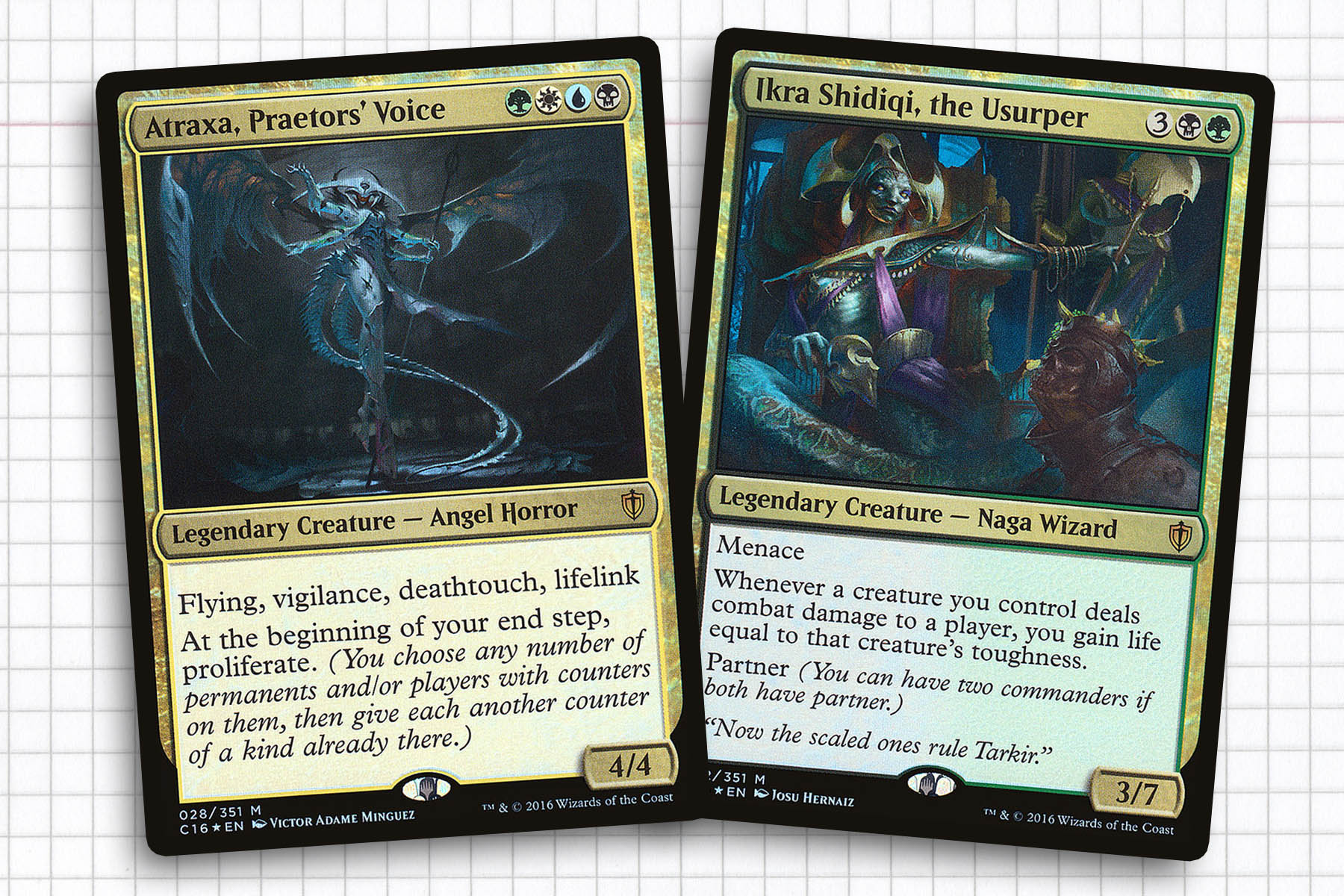
Breed Lethality
When talking about this set, it seemed foolish to start anywhere other than the deck with Atraxa, Praetors’ Voice as the marquee general. While I would be inclined to say the most of the decks were favorably received in their day, Breed Lethality was far and away the most coveted of the five decks released that year. Since their printing, Atraxa has been in the top three generals of the format and currently tops the list (after the banning of Golos, Tireless Pilgrim in September 2021). I was critical of Atraxa for a long time, but I have since calmed down some, as the diversity of decks captained by them has grown past being almost entirely Superfriends.
It’s not even hard to see why Atraxa has such near-universal appeal. Of the five marquee cards, with only 12 words of rules text, it is the most simple when just reading the card. But the applications of Atraxa are vast and open to immense interpretation. Magic becomes more of a game about accounting and resource management with each passing year and that’s something Atraxa, Praetors’ Voice interacts with very well.
Unlike past products, these decks did not have substitute generals that could cleanly replace the marquee general. Instead, they supplied us with three generals that could be paired together (using the brand new partner mechanic introduced in Commander 2016) to substitute for the general on the front of the box. Within the context of this deck, Ishai, Ojutai Dragonspeaker was mandatory in the general spot, with either Reyhan, Last of the Abzan or Ikra Shidiqi, the Usurper being the partner. I really appreciated that Wizards gave us more enemy colored partner commanders in the initial group, as allied pairs always get so much attention. This makes it harder to quantify how successful any of these three really are. All three come with interesting designs, with Ikra Shidiqi, the Usurper being my favorite to use within decks. Unfortunately, these three were ultimately overshadowed by Atraxa.
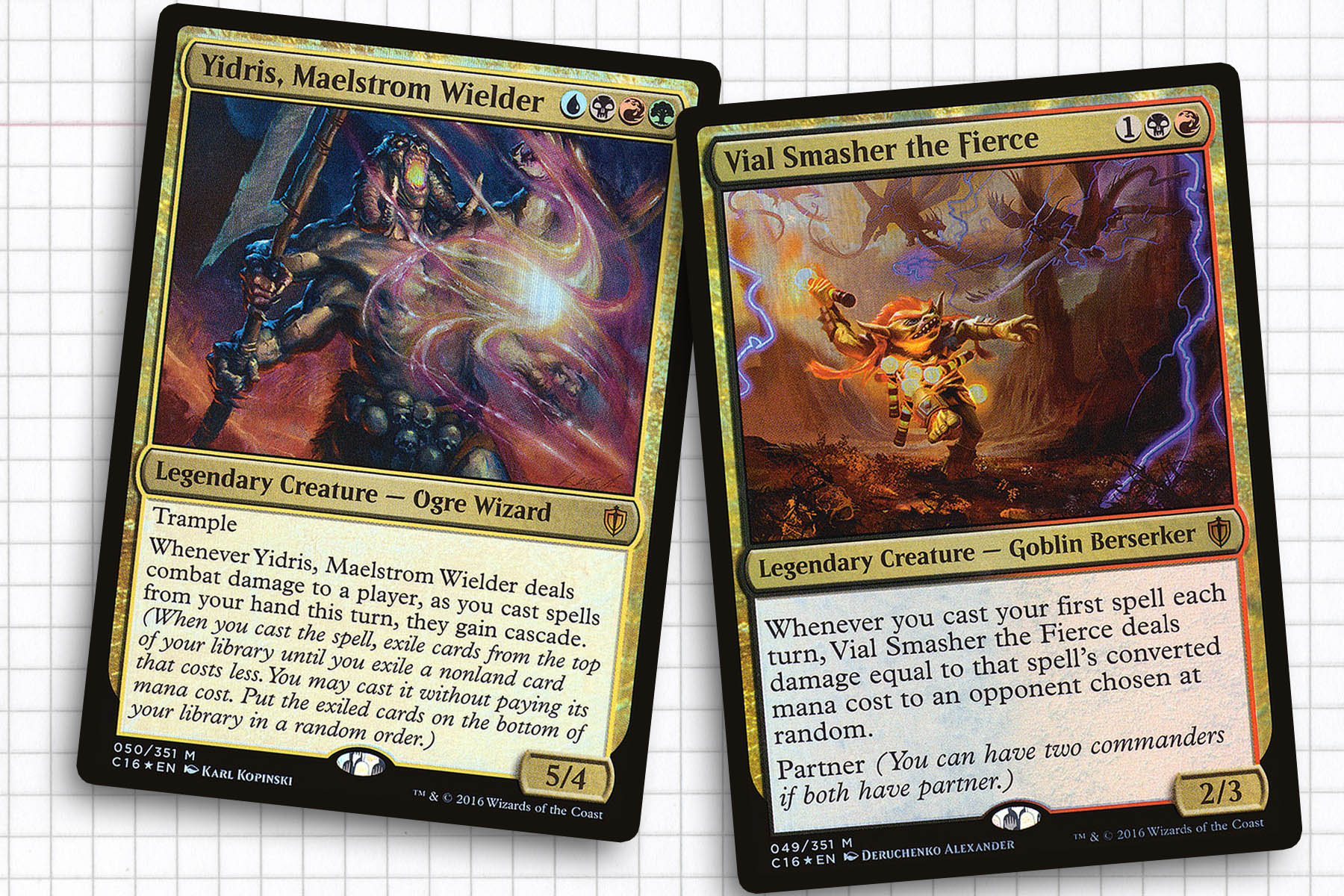
Entropic Uprising
Next up, we have the general I have most personal experience with: Yidris, Maelstrom Wielder. Due to an (almost) uncontested status as four0-color legends, it should surprise no one that the marquee generals are almost all the top generals in their respective identities. But Yidris is currently very closely followed by the partner team of Thrasios, Triton Hero and Vial Smasher the Fierce.
Maelstrom Wanderer had shown us that there was a lot of power in general being able to let you cascade and so I had a Yidris deck for a little while, as I thought he might be a good way to include blue into my Eldrazi deck and cast huge spells. But like many others, I discovered that getting cascade online was a harder feat than it seemed. Ultimately, Yidris falls outside of the Top 100 generals in the format and I really don’t see much talk of the ogre wizard.
Entropic Uprising was packed with some sweet alternative generals in Kydele, Chosen of Kruphix, Thrasios, Triton Hero, and Vial Smasher the Fierce. All three are probably familiar to players in some form, with Thrasios, Triton Hero and Vial Smasher the Fierce likely being the most iconic pair to come out of this product. In truth, I think of them more as the face of chaos decks than any other general. All three have strong designs that feel like they could support their own decks with interesting mechanics and are only improved with partner.
Thrasios is a good card that sees play everywhere, even when working alone in cEDH. When Vial Smasher isn’t hanging out with Thrasios, he’s doing work with Sakashima of a Thousand Faces, a terrifying duo. And while Kydele didn’t start out as strong, she has gained a second life with the printing of Eligeth, Crossroads Augur, creating a direction for a deck to go in.
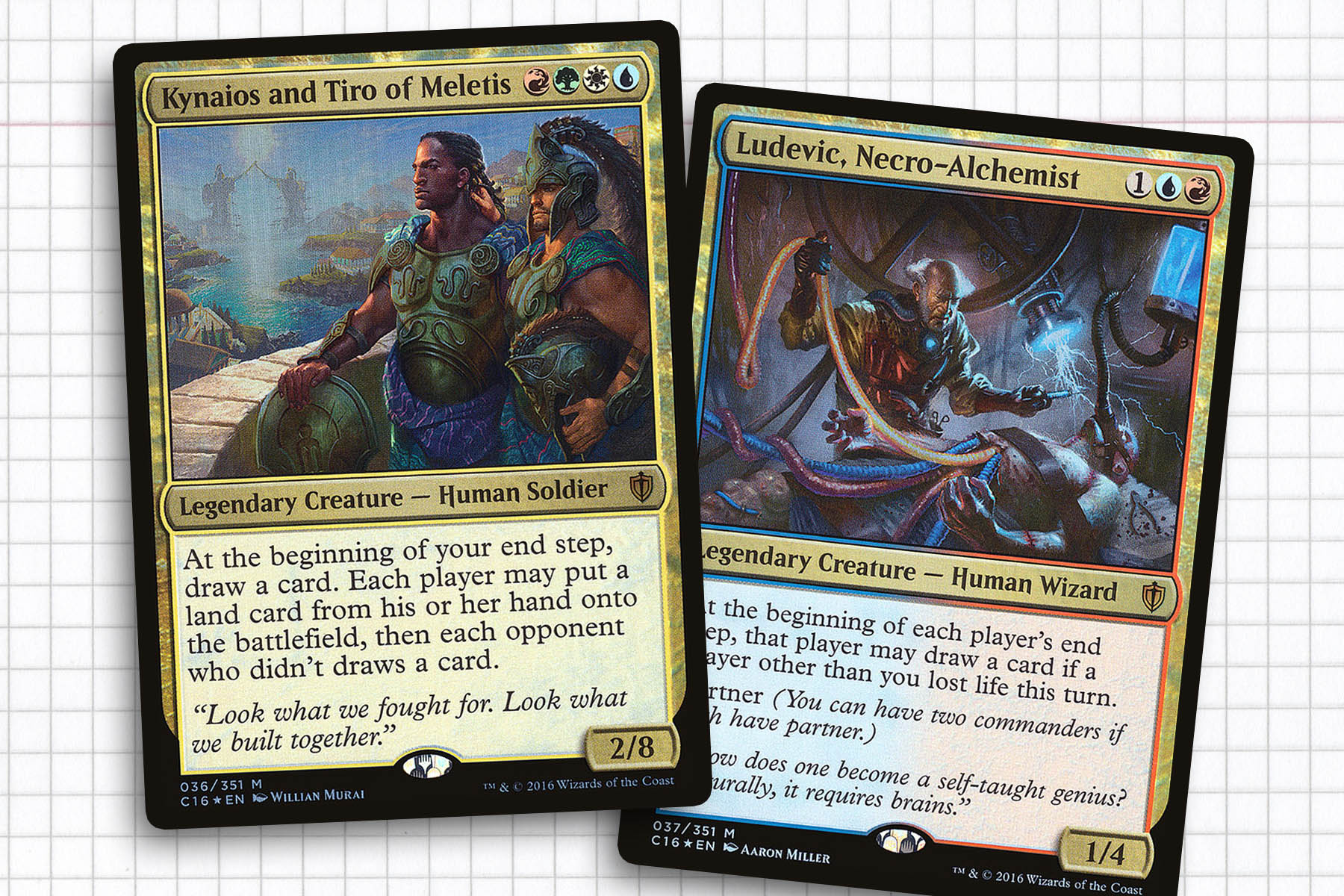
Stalwart Unity
Kynaios and Tiro of Meletis are the only general from this year’s product that has been usurped by another general in their color identities— Omnath, Locus of Creation in this case. While not as resonant as some of the other legendary creatures in the product, Kynaios and Tiro were met with a relatively warm welcome, as group hug decks don’t always get a lot of love in the Commander products. Having played with the card, I never got the pieces lined up for a win and the end step trigger often needed to be explained to the table more than a few times each game. I personally think this perceived complexity may have hurt Kynaios and Tiro in the long run, ultimately leaving them at the 80th most popular general overall. They still are the modern face of Group Hug, so it’s safe to say their design was successful in that respect.
Stalwart Unity might have the weakest trio of legendary creatures from the product line. Sidar Kondo of Jamuraa is a weird card that never reads very cleanly. He really works better as a surprise, being cast from your hand, when your opponents don’t have the ability to plan their turns around his restrictions. Then we have the pair Ludevic, Necro-Alchemist and Kraum, Ludevic’s Opus, whom I like as a duo. In tandem, they motivate your opponents to go after one another, allowing them to cast more spells, which you in turn draw cards from. The problem is, you’ve then built a partner deck solely around two Izzet generals, which is suboptimal. As a result, I find myself recommending these three more as cards in the main deck over generals.
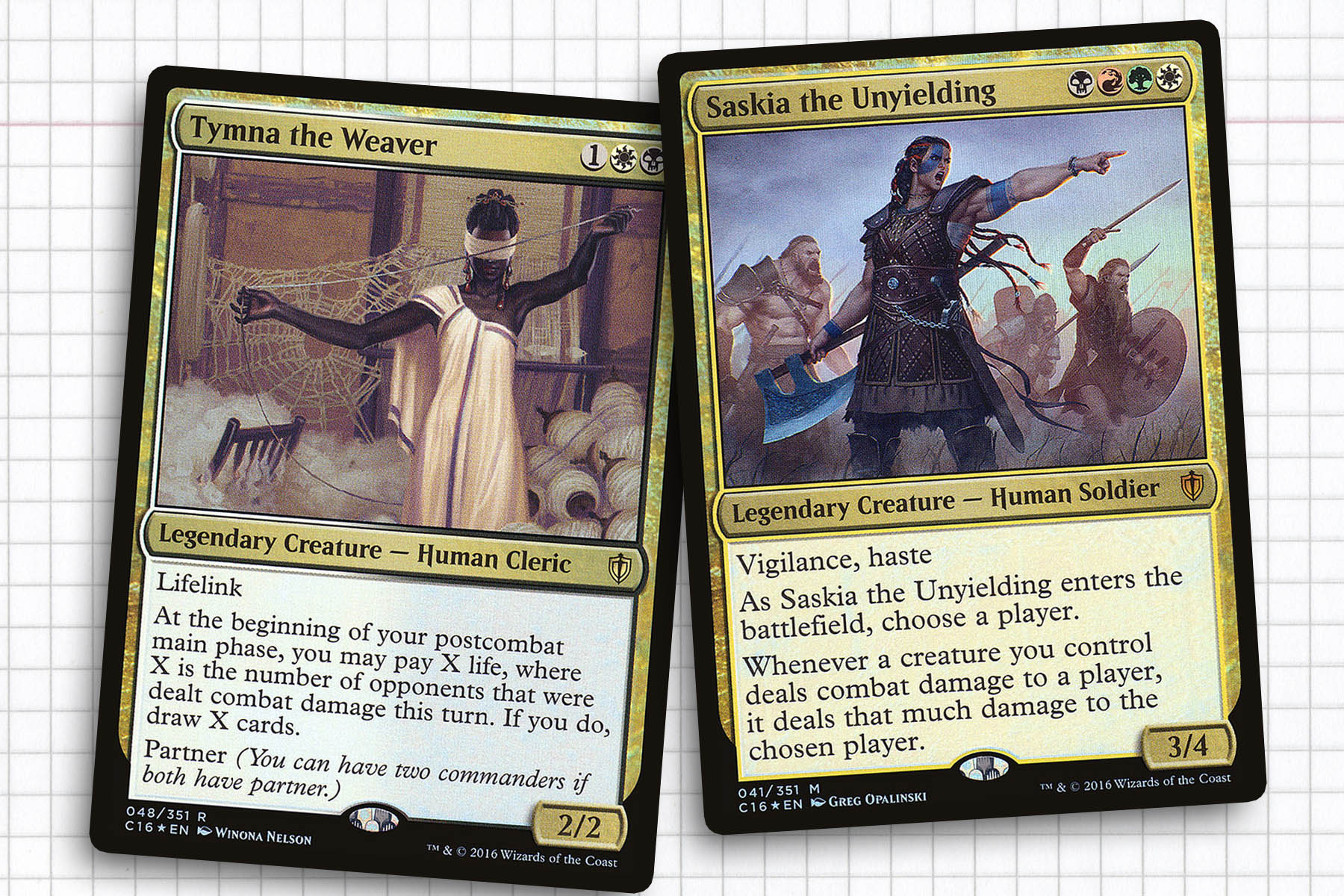
Open Hostility
The non-blue deck, Open Hostility, was fronted by Saskia the Unyielding, who started with a lot of momentum after being printed. Go-wide strategies have always had challenges closing out games but I can say from experience that this deck did not have trouble out of the box finishing games. Unfortunately, Saskia has really fallen out of style and now sits at 86th overall in popularity, which I chalk up partially to the sheer amount of diversity of aggro decks in the format. Saskia was a good attempt to answer a problem I don’t know that players needed solved.
The alternative generals for Open Hostility are an amazing suite of legendary creatures to compliment their respective marquee card. Individually, Tymna the Weaver has proven herself to be an amazing creature to partner with just about any creature-focused commander, my favorites being Ikra Shidiqi, the Usurper and Rograkh, Son of Rohgahh. She promotes combat, but provides card draw without having to put herself into it. Tana, the Bloodsower is one of the few generals I’ve seen played on her own, using pump spells and equipment to spawn a saproling tribal deck. Ravos, Soultender was never especially popular, but has lost a lot of ground since the printing of Orah, Skyclave Hierophant, which built a solid foundation for the previous weaker cleric tribal deck.
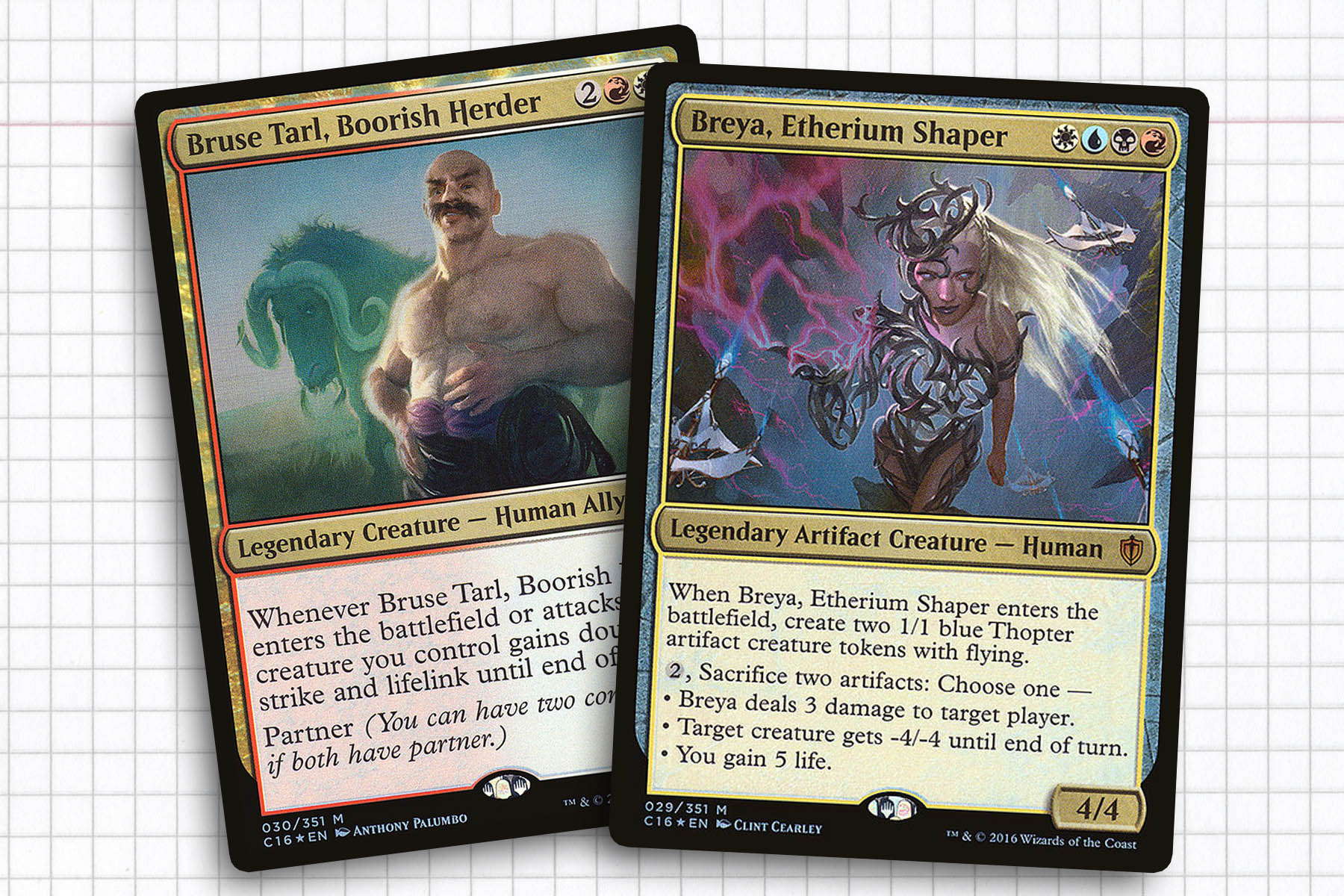
Invent Superiority
Finally, we have what was another highly coveted deck in Invent Superiority. I have always had a strong affinity for Breya, Etherium Shaper and I think a lot of the community would agree with me. While her abilities may be on the lower end of power level, the ability to sacrifice two artifacts is the key to any combo potential mad scientist brewer use her for.
Breya was a weird contradiction at the time of printing and possibly an omen of things to come in retrospect. Artifacts are a very popular archetype, but they are also historically colorless, so a four color general seemed like more of a hindrance in 2016, whereas the proliferation of colored artifacts following War of the Spark meant that Breya allowed you to take on new cards in ways that Bosh, Iron Golem and Memnarch would not have allowed. It is no surprise that Breya is the most popular general for their color identity, but they are also the 15th most popular general in format overall, a place she has hovered around since seeing print.
Of course, when the marquee general is as prolific as Breya, it ultimately means that the back-up generals are going to be a little less notable within the context of their product. Silas Renn, Seeker Adept, Bruse Tarl, Boorish Herder, and Akiri, Line-Slinger are all cards I could see myself building single decks around. In a world without Sharuum the Hegemon, Silas is a really cool artifact reanimator deck, if not a little slow to be an iconic combo deck. Bruse Tarl has never been much of a card outside of enabling Boros colors for other decks or being a solid card in the 99 of ally decks. And Akiri is just outclassed in the broad field of equipment-matters generals.
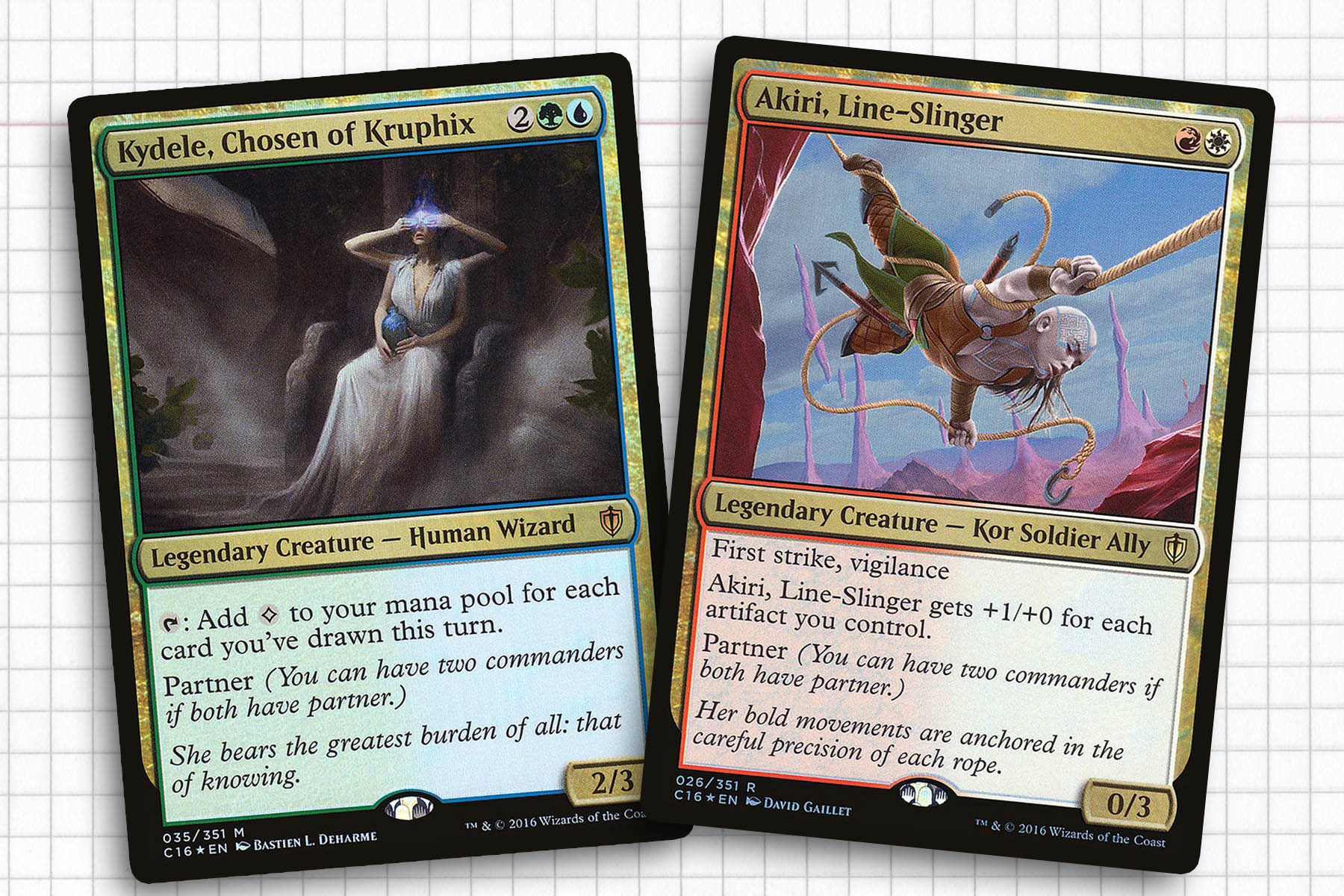
The Partner Paradox
The creation of something resembling the partner mechanic was a huge “when, not if” for Commander. By 2016, in several of my playgroups, I had already invoked Rule Zero to use two copies of Brothers Yamazaki as my commanders, along with a deck that had Isao, Enlightened Bushi and Nagao, Bound by Honor as a tag team, as well. Wizards making it a canon mechanic was amazing when I first heard it was happening, but I feel like the first execution wasn’t calibrated right.
For the most part, I actually think that the partner generals have a lot of cool designs, some of which would be fine generals leading their own individual decks, like Thrasios, Triton Hero. But the elephant in the room is that you’re giving up some amount of design space by not expanding Thrasios’s potential with a partner like Vial Smasher the Fierce or Ikra Shidiqi, the Usurper. Suddenly, entirely capable cards were being treated like half of a card. But this also created an issue, because a lot of pairings felt like the generals were pulling decks in different directions. Take Akiri, Line-Slinger and Kydele, Chosen of Kruphix. Of all the possible pairings, I choose to put these two together, but what is this deck trying to accomplish?
Wizards learned a lot of good lessons from partner’s debut and the mechanic has lost some of its parasitic nature as it has been reused over the last six years. Wizards has even gone so far as to capture a little bit of that Brothers Yamazaki feel by giving us pairs like Breeches, Brazen Plunderer and Malcolm, Keen-Eyed Navigator that are left open ended, just in case you’d rather use Ghost of Ramirez DePietro with one of them instead. Partner is not my favorite mechanic, but I’m not in the “it was a mistake” camp, even on its first outing. It’s done a lot of good for creating some amount of diversity, simply due to the astounding amount of pairings possible.
Regardless of any qualms the community or I may have with Commander 2016, especially partners, the product was very exciting at the time and I am of the opinion that it is one of the high points of the Commander product line. Not only did it open us up to four-color identities that we didn’t have access to before, it created some of the most popular generals in the format. I would like to see another round of four-color generals, but I don’t entirely think that the format needs a high saturation of them.
The next installment of this series should come much quicker, in it we will be looking at the legends housed within the four tribal decks of Commander 2017. Until then, thank you for reading.
Ryan Sainio is a Graphic Designer who writes about EDH and the EDH community. He has been playing Magic: the Gathering since 7th Edition in 2002 and values flavorful and fun gameplay over competitively optimized decks.

